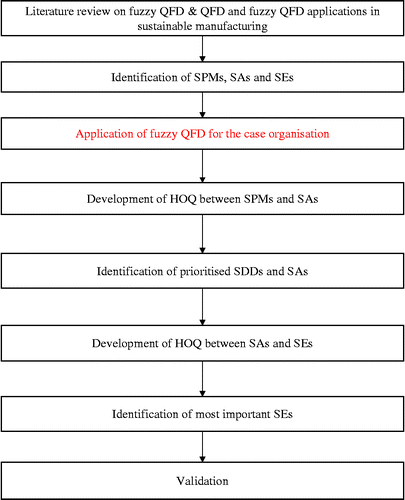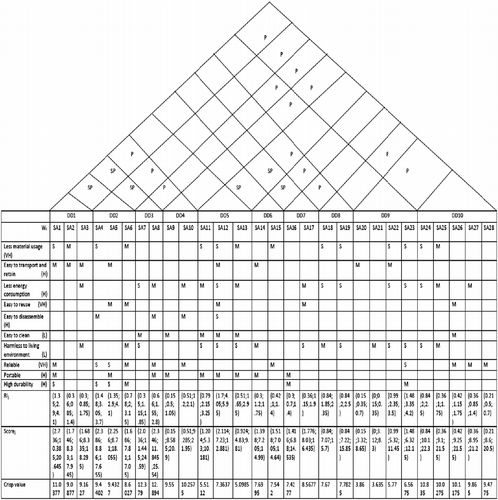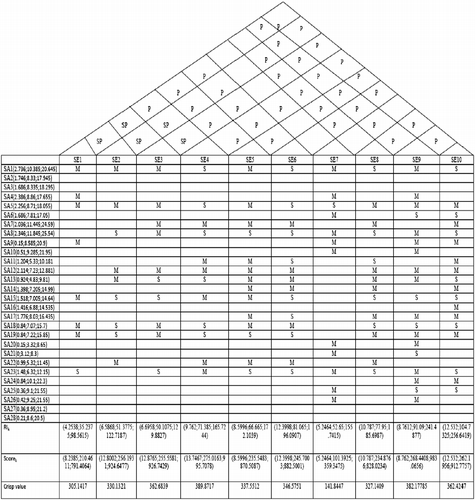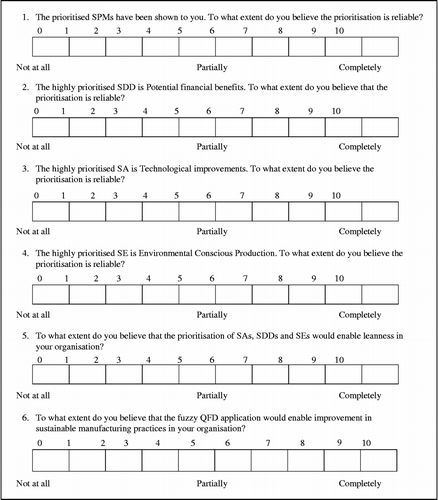Abstract
Contemporary manufacturing organisations recognise sustainability as an important concept for survival. Environmental awareness and recycling regulations have been compelling manufacturers and consumers to evolve sustainable strategies. The modern customers' voices need to be translated with care into technical requirements. Quality function deployment (QFD) is a technique extensively used for this purpose. In order to cope with the vagueness associated with relationships and correlations in QFD, fuzzy numbers have been integrated within a QFD framework and fuzzy QFD has been used in this study. The study is concerned with the application of fuzzy QFD for enabling sustainability in an Indian modular switches manufacturing organisation. The approach is effective in the identification of sustainable competitive bases, sustainable decision domains, sustainable attributes and sustainable enablers for the organisation. The improvement in sustainability has been measured from three perspectives. The results gained as a result of the study indicated that fuzzy QFD could be used as an enabler of sustainability.
1. Introduction
With the rise in environmental concerns among the stakeholders of businesses, firms are responding with strategic environmental marketing activities designed to meet the growing demand for environment friendly processes, products and packaging (Pujari et al. Citation2004). Manufacturing industries are confronted with a new major challenge on sustainable development due to energy and natural resources being depleted. Sustainable manufacturing is a comprehensive and holistic approach that can be used for carrying out the sustainable design of products and systems that are environmentally benign, socially equitable and economically viable. The practical aspects of sustainable design and manufacturing involve minimal material usage, improved material choices, design for ease of disassembly, product reuse, minimal energy consumption, manufacture without producing hazardous waste and the use of clean technologies. The customers have been gaining vital importance in the modern contemporary scenario. Quality function deployment (QFD) is widely used as a technique for customer voice translation (Chan and Wu Citation2002). The integration of fuzzy numbers within a QFD framework overcomes the vagueness and ambiguity associated with the relationships and correlations in QFD. Fuzzy QFD is concerned with the scientific priorities of the sustainable performance measures (SPMs), sustainable attributes (SAs) and sustainable enablers (SEs). Sustainable decision domains (SDDs) are the sustainable criteria and SAs are the ways through which the criteria could be met. SEs are the SEs which are the technologies/strategies enabling sustainable practices. The research questions addressed in this study include the scientific prioritisation of SPMs, SAs and SEs for identifying the improvement areas of sustainability. This kind of prioritisation enables contemporary manufacturing systems to identify the improvement areas and thereby improve the strategic sustainable position of the organisation among their competitors. Fuzzy QFD also enables the organisation to identify the improvement areas thereby enabling the improvement in sustainability. The contribution of the research study is that it is a new direction to apply fuzzy QFD for enabling sustainability. The study provides evidence of real application for advanced sustainable manufacturing practice in a modular switches manufacturing organisation. The uniqueness of the study is that it is the first attempt to apply fuzzy QFD for ensuring sustainability.
2. Literature review
The literature has been reviewed from the following two perspectives:
| • | fuzzy QFD applications in manufacturing and | ||||
| • | QFD and fuzzy QFD applications in sustainable manufacturing. | ||||
2.1 Literature review on fuzzy QFD applications in manufacturing
Zhou (Citation1998) presented a fuzzy logic and optimisation model for implementing QFD. The author presented the engineering characteristics that affect product performance and the ways in which they could be improved to maximise customer satisfaction. A new approach was proposed to address the difficulties due to the uncertainty of data and lack of quantitative tools. Vanegas and Labib (Citation2001) have proposed a novel method of determining optimal targets in the QFD process. Fuzzy numbers are used to represent the imprecise nature of the judgements, and to more appropriately define the relationships between engineering characteristics and customer attributes. Constraints such as cost, technical difficulty and market position are considered in the study. Fung et al. (Citation2002) have optimised product design resources using a nonlinear fuzzy QFD model. They presented a case study to illustrate the benefits of their model to enable decision makers to deploy their design resources for gaining customer satisfaction. In the model, the resources for achieving the design target for certain technical attributes are expressed in a nonlinear formulation of its relationship and correlation as well as interdependence with other customer requirements. The concepts of the achieved attainments and planned attainments for technical attributes, and the corresponding primary costs, planned costs and actual costs were introduced. Liu (Citation2005) has rated various design requirements in fuzzy QFD using a mathematical programming approach. The author illustrated the proposed method using an example of flexible manufacturing systems design. Chen et al. (Citation2006) proposed a fuzzy weighted average method to rank technical attributes in a fuzzy QFD process. Deriving the rating order of technical attributes from input variables is a crucial step in applying QFD. When the relative weights of customer requirements and the relationship measures between customer requirements and technical attributes are expressed as fuzzy numbers, it is difficult to proceed further. Thus, most ranking methods are not suitable under these circumstances. This paper proposes a fuzzy weighted average method in the fuzzy expected value operator in order to rank technical attributes in fuzzy QFD. Kahraman et al. (Citation2006) presented an integrated framework based on fuzzy QFD and a fuzzy optimisation model was proposed to determine the product technical requirements to be considered in designing a product. The coefficients of the objective function were obtained from a fuzzy analytic network process approach. A fuzzy analytic hierarchy process was also used in the proposed framework. Buyukozkan et al. (Citation2007) presented a new fuzzy group decision-making approach to blend multiple preference styles to respond to customer needs in product development in a better way. Lee et al. (Citation2008) presented an integrated approach by incorporating Kano model with fuzzy mode into the QFD matrix and adjusting customer requirements' weights. They suggested, based on an example, that their proposed approach contributes to the creation of product life cycle management attributes and innovation. Bottani (Citation2009) has presented a fuzzy QFD approach to achieve agility. Liu (Citation2009) has developed an extended fuzzy QFD approach for expanding the research scope from product planning to product deployment.
2.2 Literature review on QFD and fuzzy QFD applications in sustainable manufacturing
Pun (Citation2006) presented the determinants of environmentally responsible operations and suggested Green QFD (GQFD) as one of the tools for environmentally responsible operations. Then, a categorical analysis was conducted on QFD functional fields, applied industries and methodological development. Ten informative QFD publications were also suggested, particularly for those who are not yet familiar with QFD. Cristofari et al. (Citation1996) introduced the concept of GQFD by integrating QFD with a life cycle approach to product development. This is useful for evaluating different product concepts, and deploys environmental requirements throughout the development process. The study focused more on quality matrix problem solving and the main difficulties were reported. Zhang et al. (Citation1999) developed a method called GQFD-II which includes the integration of life cycle assessment (LCA) and life cycle costing (LCC) into QFD. The communication of the corporate performance comprises the strategic and operational goals, the corporate performance data on inventory level, the translation of the inventory data to sustainability core indicators as well as the performance evaluation in terms of sustainability. They integrated LCC into QFD matrices and suggested the deployment of quality, environmental and cost requirements throughout the entire product development process to evaluate different product concepts. The paper explored interpretations of public interest in alpine tourism management and whether different interpretations impact upon interagency collaboration. Masui et al. (Citation2003) presented a concept called quality function deployment for environment (QFDE) in which QFD has been applied to environmentally conscious (EC) design. A methodology has been developed by incorporating environmental aspects into QFD to handle environmental and traditional products simultaneously. The methodology evaluated the effects of design improvements on environmental quality requirements. Sakao (Citation2009) has presented a QFD-centred design methodology for EC product design. The author has combined LCA, QFDE and theory of inventive problem solving and applied the combination to a hair dryer to effectively support the product planning and conceptual design stages. It worked well, especially for environmental characteristics. Generation of strategies was also found to work effectively. The authors have suggested some potential of using quality engineering-oriented methods/tools to deal with customer perception in the early phase of eco-design. The research, in a broader sense, exists in the integration of marketing and design disciplines. Vinodh and Rathod (Citation2010) have presented the integration of ECQFD and LCA for sustainable product design. The authors have exemplified their approach with a case study. Based on the literature review, it has been found that the application of fuzzy QFD in the field of sustainable manufacturing is found to be feeble, which formed the motivation of this research project.
3. Methodology
The methodology followed during this study is shown in Figure .
As shown, the study begins with a literature review of fuzzy QFD & QFD and fuzzy QFD applications in sustainable manufacturing. The fuzzy numbers have been integrated within the QFD framework. This is followed by the application of fuzzy QFD for the case organisation. Then, the SPMs and their importance weights have been identified. This is followed by the development of house of quality (HOQ) between SPMs and SAs. Then, the HOQ has also been developed between SAs and SEs. Then, the most important SAs and SEs have been identified. The correlation between SDDs has been studied. Then, the case study has been practically validated to determine its feasibility in the industrial scenario.
4. Case study
This section deals with the background details of the project, and the development of HOQs between SPMs and SAs and between SAs and SEs. The fuzzy QFD approach proposed by Bottani (Citation2009) has been adopted and used for ensuring sustainability of the case organisation.
4.1 About the case company
This case study has been carried out in a modular switches manufacturing company situated in Coimbatore, Tamil Nadu, India (hereafter referred to as ABC). ABC is manufacturing cam-operated rotary switches, relays, modular switches and transformers. The number of employees currently working at ABC is 350. There existed a need for the case organisation to apply fuzzy QFD for ensuring sustainability.
4.2 Background details of the project
ABC has implemented sustainable manufacturing strategies such as the ISO 14000 Environmental Management System and methods for savings in energy and power consumption. Also, the organisation is in the process of implementing sustainable manufacturing strategies. Hence, the management of ABC is interested in the identification of the most important sustainable competitive priorities, appropriate SAs and SEs to enable them to acquire sustainable capabilities. In this context, fuzzy QFD has been identified as an approach for performing this task. This study has been aimed at the identification of sustainable competitive bases and their prioritisation, and the identification of predominant SAs and SEs for enabling ABC to attain world class sustainable capabilities. The ratings used in this study have been gathered in consultation with the manager (Standards and Systems) of ABC. The manager will be designated as an expert throughout this article.
4.3 Development of HOQ between SPMs and SAs
The goal of developing this HOQ is to prioritise the SDDs and SAs to enhance the sustainable capabilities of ABC. SPMs are referred to as ‘WHATs’ as they are used as performance measures of ABC, whereas SAs are referred to as ‘HOWs’ as they indicate the attributes that ABC should enhance to become a sustainable enterprise.
SPMs, SAs and SEs have been gathered by referring to the research articles: Gungor and Gupta (Citation1999), Petrini and Pozzebon (Citation2009) and Yan et al. (Citation2009). The developed SDDs and SAs are shown in Table .
Table 1 SDDs and their related SAs.
Fuzzy numbers have been used for indicating the relative importance (RI) of SPMs, since RI and their relationship rely upon human judgement. Triangular fuzzy numbers have been used for indicating the RI, relationships and correlations in order to overcome the vagueness associated with linguistic judgement (Bottani Citation2009). The importance weights (w i ) is a fuzzy vector representing the RI of SPMs on a linguistic fuzzy scale. The importance weights and corresponding fuzzy numbers used for rating SPMs are shown in the Table .
Table 2 Importance weights and corresponding fuzzy numbers for rating SPMs.
The relationship matrix (R
ij
) (; j = 1…m) of HOQ is a matrix whose entry (i, j) reveals how the jth SA performs against the ith SPM. The degree of relationship, the graphic symbol and the corresponding fuzzy numbers are shown in Table .
Table 3 Degree of relationship, the graphic symbol and the corresponding fuzzy numbers used in the relationship matrix.
After assessing the relationship between SPMs and SAs, the RI j of jth SA has been computed using the following formula:
Table 4 Degree of correlation, the graphic symbol and the corresponding fuzzy numbers used in the correlation matrix.
The final score of jth SA can be computed using the following equation:
The crisp value of a triangular fuzzy number is computed using the following equation:
The sample calculation for SA1 (profitability) is shown as follows:
4.4 Development of HOQ between SAs and SEs
In order to identify the SEs that satisfy SAs, HOQ between SAs and SEs has been developed. In this HOQ, SAs indicate ‘WHATs’, whereas SEs represent ‘HOWs’. The outputs derived from previous HOQ are used as the inputs for the HOQ between SAs and SEs. The estimated values of the scores of SAs have been used as RI weights.
The HOQ between SAs and SEs has been developed by adopting the previously mentioned procedure. The relationships between SAs and SEs, correlation between SEs have been computed using the following equations:
Figure depicts the HOQ developed between SAs and SEs.
A sample calculation of SE4 (environmental conscious production) follows:
5. Results and discussion
An analysis of HOQs between SPMs and SAs leads to the following inferences. SDD3 (potential financial benefits) is the decision domain with the highest crisp value.
Among SAs, the following possess the highest crisp values:
| • | SA8-technological improvements and | ||||
| • | SA7-National/International subsidies. | ||||
| • | SDD1 (financial health)–SDD2 (economic performance), | ||||
| • | SDD1 (financial health)–SDD3 (potential financial benefits), | ||||
| • | SDD2 (economic performance)–SDD3 (potential financial benefits), | ||||
| • | SDD5 (air resources)–SDD6 (water resources), | ||||
| • | SDD5 (air resources)–SDD7 (land resources) and | ||||
| • | SDD6 (water resources)–SDD7 (land resources). | ||||
5.1 Practical implications of the study
The improvements that resulted as an output of the study were presented in the following three perspectives.
5.1.1 Economic perspective
Efforts have been taken to assess the internal financial stability by means of measuring the financial health of the organisation. Further, National/International subsidies based on technological improvements have been explored.
5.1.2 Environmental perspective
Efforts have been taken to infuse sustainability characteristics in early product design phases through the implementation of integrated techniques such as ECQFD and LCA. Product designs have been evaluated for their sustainability impacts and they have been redesigned to minimise their environmental impacts.
5.1.3 Social perspective
Accordingly, ‘inclusive growth’ has been included in the vision of the organisation. Inculcation of moral and ethical values among the workforce has been included as an important task.
5.2 Managerial implications
The managerial implications include top management commitment, cross-functional team formation, total involvement of workforce and aptitude for sustainable improvements. These implications are considered to be the essential key enablers of infusing sustainable characteristics in manufacturing organisations.
5.3 Validation
In order to explore the receptivity of employing fuzzy QFD approach for enabling sustainability at ABC, a validation has been conducted using a questionnaire. The format of questionnaire is shown in Figure .
Table presents the responses of the expert. The expert is the manager (Standards and Systems) and he possesses a rich knowledge about the working culture of the case organisation. The expert has been assigned the responsibility of implementing sustainable manufacturing practices in the case organisation and hence his opinion has been gathered.
Table 5 Responses of the expert.
Besides gathering the response in Likert's scale, the overall opinion of the expert has been gathered and presented as follows: ‘Fuzzy QFD is an excellent approach that would enable our organisation to become sustainable enterprise’. Based on the analysis of the validation results, it could be inferred that fuzzy QFD could be practically deployed in the industrial scenario for enabling sustainable manufacturing practices.
6. Conclusions
The modern manufacturing organisations are focused on ensuring clean and green atmosphere by means of reduction of production cost and prevention of environmental problems. The practical aspects of sustainable manufacturing involves minimal material usage, improved material choices, design for ease of disassembly, product reuse, minimal energy consumption, manufacture without producing hazardous wastes and usage of clean technologies (Sadiq and Khan Citation2006). Modern design engineers are in need of approaches for creating sustainable products (Robert Citation2000, Gehin et al. Citation2008, Jeswani et al. Citation2010). QFD facilitates the translation of voice of customer into appropriate technical languages (Chan and Wu Citation2002). Due to the drawbacks associated with conventional QFD, fuzzy QFD has been used in the study. Two HOQs have been developed. Fuzzy numbers are used to assess the relationship and correlation of HOQs. The correlation between SDDs has been studied. The prioritised SAs and SEs identified the improvement areas for sustainability. The improvements in environmental, economic and social sustainability were determined. The validation results indicate that fuzzy QFD can be practically deployed for ensuring sustainability.
In the present study, the fuzzy QFD approach was used to ensure the sustainability of a modular switches manufacturing organisation. In future, the approach could be extended for similar manufacturing organisations for ensuring sustainability. Also, the approach could be extended for ensuring agility, leanness and flexibility of manufacturing systems.
References
- Bottani , E. 2009 . A fuzzy QFD approach to achieve agility . International Journal of Production Economics , 119 ( 3 ) : 380 – 391 .
- Buyukozkan , G. , Feyzioglu , O. and Ruan , D. 2007 . Fuzzy group decision making to multiple preference formats in quality function deployment . Computers in Industry , 58 : 392 – 402 .
- Chan , L.-K. and Wu , M.-L. 2002 . Quality function deployment: a literature review . European Journal of Operation Research , 143 : 463 – 497 .
- Chen , J.C.H. , Parker , L.J. and Lin , B. 2006 . Technopreneurship in native American businesses: current issues and future trends with a case study . International Journal of Management and Enterprise Development , 3 ( 1/2 ) : 70 – 84 .
- Cristofari , M. , Deshmukh , A. and Wang , B. 1996 . “ Green quality function deployment ” . In Proceedings of the 4th International Conference on Environmentally Conscious Design and Manufacturing 297 – 304 . Cleveland, Ohio
- Fung , R.Y.K. 2002 . Product design resources optimization using a non-linear fuzzy quality function deployment model . International Journal of Production Research , 40 ( 3 ) : 588 – 599 .
- Gehin , A. , Zwolinski , P. and Brissaud , D. 2008 . A tool to implement sustainable end-of-life strategies in the product development phase . Journal of Cleaner Production , 16 : 566 – 576 .
- Gungor , A. and Gupta , S.M. 1999 . Issues in environmentally conscious manufacturing and product recovery: a survey . Computers and Industrial Engineering , 36 : 811 – 853 .
- Jeswani , H.K. 2010 . Options for broadening and deepening the LCA approaches . Journal of Cleaner Production , 18 : 120 – 127 .
- Kahraman , C. , Ertay , T. and Buyukozkan , G. 2006 . A fuzzy optimization model for QFD planning process using analytic network approach . European Journal of Operational Research , 171 : 390 – 411 .
- Lee , Y.C. , Sheu , L.C. and Tsou , Y.G. 2008 . Quality function deployment implementation based on fuzzy Kano model: an application in PLM system . Computers and Industrial Engineering , 55 : 48 – 63 .
- Liu , S.T. 2005 . Rating design requirements fuzzy quality function deployment via a mathematical programming approach . International Journal of Production Research , 43 ( 3 ) : 497 – 513 .
- Liu , H.T. 2009 . The extension of fuzzy QFD: from product design to part deployment . Expert Systems with Applications , 36 : 11131 – 11144 .
- Masui , K. 2003 . Applying quality function deployment to environmentally conscious design . International Journal of Quality and Reliability Management , 20 ( 1 ) : 90 – 106 .
- Petrini, M. and Pozzebon, M., 2009. Managing sustainability with the support of business intelligence: integrating socio-environmental indicators and organisational context. Journal of Strategic Information Systems, 18 (4), 178–191
- Pujari , D. , Wright , G. and Peattie , K. 2004 . Organizational antecedents of environmental responsiveness in industrial new product development . Industrial Marketing Management , 33 ( 5 ) : 381 – 391 .
- Pun , K. 2006 . Determinants of environmentally responsible operations: a review . International Journal of Quality and Reliability Management , 23 ( 3 ) : 279 – 297 .
- Robert , K.-H. 2000 . Tools and concepts for sustainable development, how do they relate to a general framework for sustainable development, and to each other . Journal of Cleaner Production , 8 : 243 – 254 .
- Sadiq , R. and Khan , F.I. 2006 . An integrated approach for risk-based life cycle assessment and multi-criteria decision-making selection, design and evaluation of cleaner and greener processes . Business Process Management Journal , 12 ( 6 ) : 770 – 792 .
- Sakao , T. 2009 . Quality engineering for early stage of environmentally conscious design . TQM Journal , 21 ( 2 ) : 182 – 193 .
- Vanegas , L.V. and Labib , A.W. 2001 . A fuzzy quality function deployment (FQFD) model for deriving optimum targets . International Journal of Production Research , 39 ( 1 ) : 99 – 120 .
- Vinodh, S. and Rathod, G., 2010. Integration of ECQFD and LCA for sustainable product design. Journal of Cleaner Production, 18 (8), 833–842
- Yan , W. , Chen , C.-H. and Chang , W. 2009 . An investigation into sustainable product conceptualization using a design knowledge hierarchy and Hopfield network . Computers and Industrial Engineering , 56 : 1617 – 1626 .
- Zhang , Y. , Wang , H.-P. and Zhang , C. 1999 . Green QFD-II: a life cycle approach for environmentally conscious manufacturing by integrating LCA and LCC into QFD matrices . International Journal of Production Research , 37 ( 5 ) : 1075 – 1091 .
- Zhou , M. 1998 . Fuzzy logic and optimization models for implementing QFD . Computers and Industrial Engineering , 35 ( 1–2 ) : 237 – 240 .



